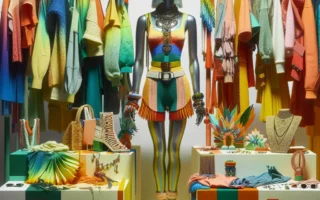The History of Sustainable Fashion
When we think of sustainable fashion, we often associate it with modern trends and innovations. However, the history of sustainable fashion dates back much further than one might expect. The concept of sustainability in fashion can be traced back to the early 20th century when the first signs of concern for the environment and ethical production practices emerged.
During the 1920s and 1930s, the global economic depression prompted a shift towards sustainable and thrifty fashion choices. People began to mend and repurpose their clothing, giving rise to a culture of reusing and recycling garments. This era marked the beginning of conscious consumerism in the fashion industry.
Fast forward to the 1960s and 1970s, the environmental movement gained momentum, leading to an increased focus on eco-friendly materials and production methods in the fashion world. Designers started utilizing organic fabrics and experimenting with natural dyes, laying the groundwork for the sustainable fashion practices we see today.
As we entered the 21st century, the detrimental effects of fast fashion became more apparent, prompting a widespread call for sustainable alternatives. This paved the way for a surge in eco-conscious fashion brands and initiatives, further propelling the evolution of sustainable fashion trends.
In essence, the history of sustainable fashion is a story of resilience, innovation, and adaptation. From the early practices of reusing and recycling to the modern ethos of eco-friendly materials and ethical production, the journey towards sustainability in fashion has been a continuous evolution, shaped by societal, economic, and environmental factors.
Innovations in Eco-Friendly Fabrics
Eco-friendly fabrics have revolutionized the fashion industry, paving the way for sustainable trends to emerge. Innovations in eco-friendly fabrics have played a pivotal role in reshaping the landscape of fashion, offering a viable alternative to traditional fabric production methods. As the demand for sustainable fashion continues to grow, the development of eco-friendly fabrics has become a focal point for designers and manufacturers alike.
One of the most significant advancements in eco-friendly fabrics is the utilization of organic cotton. Unlike conventional cotton, organic cotton is grown without the use of synthetic pesticides and fertilizers, reducing its environmental impact significantly. Additionally, advancements in textile technology have led to the creation of organic cotton blends, further enhancing the versatility and durability of this eco-friendly fabric.
Another noteworthy innovation in sustainable fabrics is the emergence of recycled polyester. By transforming post-consumer plastic bottles into wearable textiles, recycled polyester presents a sustainable solution to reduce plastic waste while offering a high-performance fabric for clothing production. This innovation highlights the potential for circular fashion, where materials are repurposed and recycled to minimize the industry’s environmental footprint.
Bamboo fabric is also gaining traction as a sustainable alternative in the fashion industry. Known for its rapid growth and minimal need for irrigation and pesticides, bamboo is a highly renewable resource. The fabric derived from bamboo is not only environmentally friendly but also possesses natural antibacterial and moisture-wicking properties, making it an attractive choice for eco-conscious consumers.
In conclusion, the evolution of sustainable fashion trends is closely intertwined with the continuous innovations in eco-friendly fabrics. As designers and manufacturers embrace these advancements, the fashion industry is moving towards a more sustainable and environmentally conscious future.
Ethical Practices in the Fashion Industry
As the fashion industry evolves, sustainable and ethical practices have become increasingly important. Consumers are becoming more aware of the environmental and social impact of the fashion industry, and as a result, there has been a growing demand for ethically produced clothing. This shift in consumer behavior has prompted many fashion brands to incorporate ethical practices into their business models.
Ethical practices in the fashion industry encompass various aspects, including fair labor conditions, use of eco-friendly materials, and transparent supply chains. Many fashion brands are now prioritizing fair wages and safe working conditions for garment workers, particularly in developing countries where labor exploitation has been a longstanding issue. In addition, there is a greater emphasis on using sustainable and biodegradable materials, such as organic cotton, recycled polyester, and hemp, to reduce the environmental impact of clothing production.
Furthermore, transparency in the supply chain has become a key focus for ethical fashion brands. Consumers are increasingly interested in knowing the origins of the clothing they purchase, including the sourcing of materials and the production process. This has led to a push for greater transparency and accountability throughout the entire supply chain, as brands seek to build trust and confidence with their customers.
In conclusion, the evolution of sustainable fashion trends has brought about a significant emphasis on ethical practices within the fashion industry. By incorporating fair labor conditions, eco-friendly materials, and transparent supply chains, fashion brands are responding to the shifting priorities of consumers and working towards a more sustainable and ethically conscious future.
The Rise of Circular Fashion Economy
In recent years, the fashion industry has seen a significant shift towards sustainability, with the rise of the circular fashion economy playing a pivotal role in this evolution. The concept of circular fashion focuses on creating a closed-loop system, where materials are recycled, reused, and repurposed to minimize waste and reduce the environmental impact of the industry. This shift has led to the emergence of innovative business models that prioritize longevity, durability, and recyclability of products.
One of the key drivers of the circular fashion economy is the growing consumer demand for ethically produced and environmentally friendly clothing. As more consumers become aware of the impact of fast fashion on the environment, there has been a noticeable shift towards supporting brands that embrace sustainable and circular practices. This has prompted fashion companies to reevaluate their production processes and supply chains, leading to the adoption of eco-friendly materials, zero-waste manufacturing, and clothing take-back programs.
Furthermore, technological advancements have played a crucial role in advancing circular fashion initiatives. From 3D knitting and on-demand manufacturing to digital platforms for clothing resale and rental, technology has enabled new ways of prolonging the lifespan of garments and minimizing waste. These innovations not only contribute to the reduction of textile waste but also present economic opportunities for businesses to explore new revenue streams and business models.
As the circular fashion economy continues to gain momentum, it is reshaping the entire fashion industry, from design and production to consumption and disposal. By promoting a more sustainable and responsible approach to fashion, the rise of circular fashion represents a fundamental shift towards a more regenerative and restorative industry that is focused on preserving resources and minimizing its environmental footprint.
Consumer Empowerment in Sustainable Fashion
Consumer Empowerment in Sustainable Fashion
In recent years, the fashion industry has witnessed a significant shift towards sustainable practices in response to the growing consumer demand for ethically produced and environmentally friendly clothing. This shift towards sustainability in fashion has been largely driven by consumer empowerment, as more and more individuals are becoming aware of the impact of their purchasing decisions on the environment and society.
Consumers are now actively seeking out brands that prioritize ethical and sustainable production methods, leading to an increased availability of eco-friendly and socially responsible fashion options. This consumer demand has forced traditional fashion brands to re-evaluate their sourcing and production practices, resulting in a noticeable shift towards sustainability across the industry.
Additionally, the rise of social media and online platforms has provided consumers with greater access to information about the environmental and social impact of the fashion industry. As a result, consumers are now able to make more informed choices and hold brands accountable for their actions, further empowering them to drive the demand for sustainable fashion.
Moreover, the concept of consumer empowerment in sustainable fashion extends beyond making purchasing decisions. Consumers are increasingly advocating for transparency and ethical practices within the industry, influencing brands to adopt more sustainable and transparent supply chains. This growing awareness and advocacy from consumers are driving a positive transformation in the fashion industry, leading to the development of innovative sustainable materials, production techniques, and circular fashion models.
In conclusion, consumer empowerment plays a pivotal role in shaping the evolution of sustainable fashion trends. As consumers continue to demand transparency, ethical practices, and environmentally friendly products, the fashion industry will be compelled to prioritize sustainability, ultimately leading to a more responsible and sustainable future for fashion.
Impact of Technology on Sustainable Fashion
As sustainable fashion continues to gain momentum, the role of technology in shaping and advancing this movement cannot be overstated. The impact of technology on sustainable fashion trends has been profound, influencing every aspect of the industry from design and production to retail and consumer behavior.
Advancements in technology have revolutionized the materials used in sustainable fashion. Innovations such as recycled fabrics, bio-based materials, and 3D printing have enabled designers to create clothing that is not only eco-friendly but also stylish and functional. These technological developments have expanded the possibilities for sustainable fashion, allowing for greater creativity and innovation in the design process.
Moreover, technology has played a crucial role in improving the transparency and traceability of fashion supply chains. Blockchain, for example, has been leveraged to provide consumers with access to detailed information about the origins of the clothing they purchase, ensuring that ethical and sustainable practices are upheld throughout the production process.
Additionally, the rise of e-commerce and digital marketing has facilitated the growth of sustainable fashion brands by providing them with a platform to reach a global audience. Social media and online marketplaces have become powerful tools for promoting sustainable fashion, driving consumer awareness and demand for ethically produced clothing.
In conclusion, the integration of technology into sustainable fashion has propelled the industry forward, enabling greater innovation, transparency, and accessibility. As technology continues to evolve, its impact on sustainable fashion trends is likely to bring about further positive changes, driving the industry towards a more sustainable and ethical future.
Future Forecast for Sustainable Fashion
As we look forward to the future of sustainable fashion, it’s clear that the industry is shifting towards more eco-friendly and ethical practices. One of the key future trends in sustainable fashion is the use of innovative materials and technologies. We can expect to see a rise in the use of materials such as recycled polyester, organic cotton, and innovative fabrics made from agricultural by-products.
Furthermore, the future of sustainable fashion is likely to be shaped by a focus on circular economy principles. This means that the industry will increasingly prioritize recycling, upcycling, and the use of biodegradable materials. Additionally, there will be a growing emphasis on extending the lifespan of clothing through repair and reuse, as well as rental and resale models.
Another important aspect of the future forecast for sustainable fashion is the integration of technology to enhance transparency and traceability in the supply chain. Blockchain technology, for example, can be utilized to provide consumers with information about the origins and production processes of their garments, thus fostering greater trust and accountability.
Finally, the future of sustainable fashion will also be marked by a shift towards more inclusive and diverse representation. The industry is expected to embrace body positivity, diversity in sizing, and a celebration of individual style, thereby challenging traditional beauty standards and promoting a more inclusive and empowering fashion landscape.
In conclusion, the future of sustainable fashion holds great promise, with a focus on innovative materials, circular economy principles, technological integration, and inclusive representation. These trends are set to shape the industry in the years to come, driving it towards a more ethical, eco-friendly, and socially conscious future.



